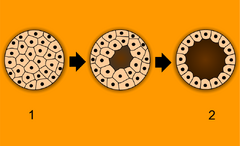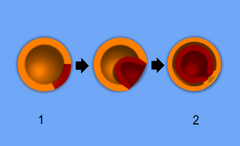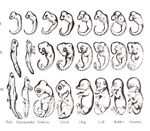Assessment |
Biopsychology |
Comparative |
Cognitive |
Developmental |
Language |
Individual differences |
Personality |
Philosophy |
Social |
Methods |
Statistics |
Clinical |
Educational |
Industrial |
Professional items |
World psychology |
Developmental Psychology: Cognitive development · Development of the self · Emotional development · Language development · Moral development · Perceptual development · Personality development · Psychosocial development · Social development · Developmental measures
Embryology is the study of the development of an embryo. An embryo is defined as any organism in a stage before birth or hatching.
Embryology is of significance to psychologists for a number of reasons:-
- It is the process by which genetic instructions are reproduced in anatomical form
- The process illuminates interesting relationships between physical structures that are derived from the same initial material.
- William Sheldon in his theory of somatypes understood that body types arose through embrological processes and that particular organizations of anatomical structures gave individuals different needs and constitutions which he felt were reflected in personality types
- [[Embryology is the study of the development of an embryo. An embryo is defined as any organism in a stage before birth or hatching.
Morula, 8 cell stage
Embryology refers to the development of the fertilized egg cell (zygote) and its differentiation into tissues and organs. After cleavage, the dividing cells, or morula, becomes a hollow ball, or blastula, which develops a hole or pore at one end.

1 - morula, 2 - blastula
In animals, the blastula develops in one of two ways that divides the whole animal kingdom into two halves. If in the blastula the first pore (blastopore) becomes the mouth of the animal, it is a protostome; if the first pore becomes the anus then it is a deuterostome. The protostomes include most invertebrate animals, such as insects, worms and molluscs, while the deuterostomes includes more advanced animals including the vertebrates. In due course, the blastula changes into a more differentiated structure called the gastrula.

1 - blastula, 2 - gastrula with blastopore; orange - ectoderm, red - endoderm.
The gastrula with its blastopore soon develops three distinct layers of cells (the germ layers) from which all the bodily organs and tissues then develop:
- The innermost layer, or endoderm, gives rise to the digestive organs, lungs and bladder.
- The middle layer, or mesoderm, gives rise to the muscles, skeleton and blood system.
- The outer layer of cells, or ectoderm, gives rise to the nervous system and skin.
In humans, the term embryo refers to the ball of dividing cells from the moment the zygote implants itself in the uterus wall until the end of the eighth week after conception. Beyond the eighth week, the developing human is then called a fetus. Embryos in many species often appear similar to one another in early developmental stages. The reason for this similarity is because species have adapted into the environment of pregnancy. These similarities among species are called analogous structures, which are structures that have the same or similar function and mechanism, but evolved separately.
Human embryo at six weeks gestational age
Histological film 10 day mouse embryo
Vertebrate and invertebrate embryology
Many principles of embryology apply to both invertebrate animals as well as to vertebrates.[1] Therefore, the study of invertebrate embryology has advanced the study of vertebrate embryology. However, there are many differences as well. For example, numerous invertebrate species release a larva before development is complete; at the end of the larval period, an animal for the first time comes to resemble an adult similar to it parents. Although invertebrate embryology is similar in some ways for different invertebrate animals, there are also countless variations. For instance, while spiders proceed directly from egg to adult form many insects develop through at least one larval stage.
Beetle larvae
Modern embryology research
Currently, embryology has become an important research area for studying the genetic control of the development process (e.g. morphogens), its link to cell signalling, its importance for the study of certain diseases and mutations and in links to stem cell research.
See also
- Ontogeny
- Embryogenesis
- Recapitulation theory
- Prenatal development
- Protostomes
- Deuterostomes
- Germ layers
- Epigenesis (biology)
- Developmental biology
- Cell signalling
- Hedgehog signaling pathway
- Morphogens
- Embryo drawing
Footnotes
- ↑ Parker, Sybil. "Invertebrate Embryology," McGraw-Hill Encyclopedia of Science & Technology (McGraw-Hill 1997).
References
- UNSW Embryology Large resource of information and media
- [1] Definition of embryo according to Webster
Further reading
- Scott F. Gilbert. Developmental Biology. Sinauer, 2003. ISBN 0-87893-258-5.
- Lewis Wolpert. Principles of Development. Oxford University Press, 2006. ISBN 0-19-927536-X.
External links
- Embryo Research UK philosophy and ethics website discussing the ethics of embryology
- Human embryo research Canadian website covering the ethics of human embryo research
- University of Indiana's Human Embryology Animations
- The Developing Human (Keith L.Moore) http://www.youtube.com/watch?v=Rb0uZefwQnc
| Mammalian development of embryo and development and fetus (some dates are approximate - see Carnegie stages) - edit |
|---|
|
Week 1: Zygote | Morula | Blastula/Blastomere/Blastosphere | Archenteron/Primitive streak | Blastopore | Allantois | Trophoblast (Cytotrophoblast | Syncytiotrophoblast | Gestational sac) Week 2: Yolk sac | Vitelline duct | Bilaminar disc Week 3: Hensen's node | Gastrula/Gastrulation | Trilaminar embryo Branchial arch (1st) | Branchial pouch | Meckel's cartilage | Somite/Somitomere | Germ layer (Ectoderm, Endoderm, Mesoderm, Chordamesoderm, Paraxial mesoderm, Intermediate mesoderm, Lateral plate mesoderm) |
| Histogenesis and Organogenesis |
|
Circulatory system: Primitive atrium | Primitive ventricle | Bulbus cordis | Truncus arteriosus | Ostium primum | Foramen ovale | Ductus venosus | Ductus arteriosus | Aortic arches | Septum primum | Septum secundum | Cardinal veins Nervous system: Neural development/Neurulation | Neurula | Neural folds | Neural groove | Neural tube | Neural crest | Neuromere (Rhombomere) | Notochord | Optic vesicles | Optic stalk | Optic cup Digestive system: Foregut | Midgut | Hindgut | Proctodeum | Rathke's pouch | Septum transversum Urinary/Reproductive system: Urogenital folds | Urethral groove | Urogenital sinus | Kidney development (Pronephros | Mesonephros | Ureteric bud | Metanephric blastema) | Fetal genital development (Wolffian duct | Müllerian duct | Gubernaculum | Labioscrotal folds) Glands: Thyroglossal duct Uterine support: Placenta | Umbilical cord (Umbilical artery, Umbilical vein, Wharton's jelly) | Amniotic sac (Amnion, Chorion) |
Prenatal development/Mammalian development of digestive system | |
|---|---|
| Gut | |
| Mesentery |
Dorsal mesentery - Ventral mesentery |
| Other |
Stomodeum - Proctodeum - Rathke's pouch - Septum transversum - Pancreatic bud - Buccopharyngeal membrane - Urorectal septum |
Prenatal development/mammalian embryogenesis - Development of the urinary and reproductive organs | |
|---|---|
| General Urinary/Reproductive system |
Cloacal membrane - Cloaca - Urethral groove - Urogenital sinus - Urachus - Urogenital folds |
| Kidney development |
Nephrogenic cord - Nephrotome - Pronephros - Mesonephros (Mesonephric tubules) |
| Fetal genital development - primarily internal |
Gonadal ridge - Sex cord (Cortical cords, Testis cords) |
| Primarily external |
Genital tubercle - Phallus - Labioscrotal folds |
|
see also list of homologues of the human reproductive system | |
Prenatal development/Mammalian development of circulatory system | |
|---|---|
| Vascular |
Blood island
arteries: Dorsal aorta - Aortic arches - Vitelline arteries - Ductus arteriosus - Umbilical artery |
| Heart development |
Primitive heart tube: Truncus arteriosus - Bulbus cordis - Primitive ventricle - Primitive atrium - Sinus venosus Septum primum (Ostium primum, Ostium secundum) - Septum secundum (Foramen ovale) - other septa (Endocardial cushions/Septum intermedium, Aorticopulmonary septum) - Atrial canal |
Template:Development of respiratory system Template:Embryology of head and neck
| This page uses Creative Commons Licensed content from Wikipedia (view authors). |

